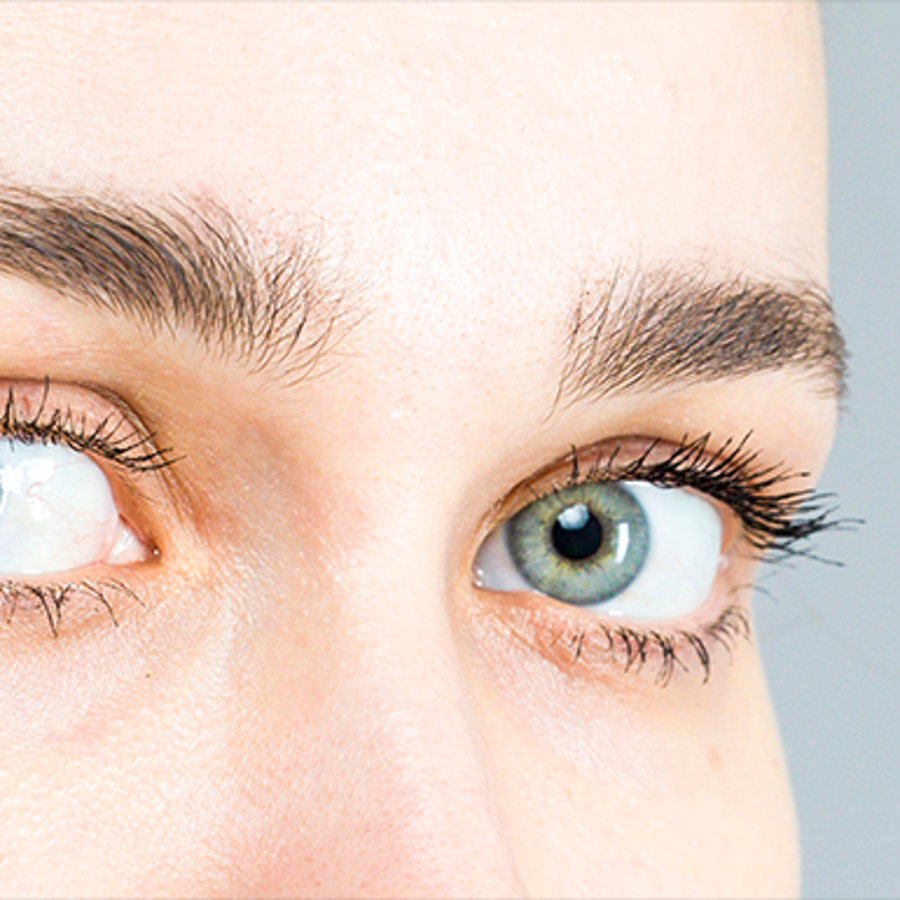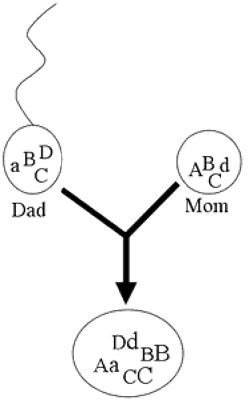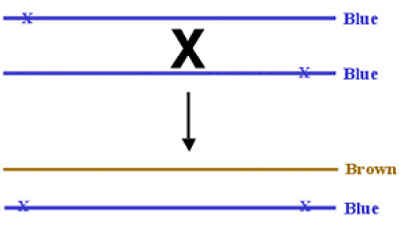
Can two blue-eyed parents have a green or brown-eyed child?
July 2, 2004

- Related Topics:
- Complex traits,
- Pigmentation traits,
- Eye color
Many people ask:
“Is there any possible way for two blue-eyed parents to have a green or brown-eyed child?”
– A curious adult from Pennsylvania
“Is it possible for a green-eyed person and a blue-eyed person to have a brown-eyed child?”
– A curious adult from Kentucky
“I understand that blue is recessive and that in theory all children of two blue-eyed parents should have blue eyes. But my parents are blue-eyed and have 2 green-eyed children and 1 blue-eyed child. So, how did I end up with green eyes? And yes, he is my father. My high school Bio teacher embarrassed me by announcing to the entire class that he couldn't be when we studied eye color.”
– A curious adult from California
“Can blue eyes + blue eyes = brown eyes? My cousin's parents both had blue eyes, but hers are dark brown! I thought I knew enough genetics to know that blue + blue yields ONLY blue eyes. Her sister had blonde hair and blue eyes, and used to tease her about being adopted (she wasn't). And my family used to tell the story that my cousin's mother thought she had been given the wrong baby at the hospital. My cousin must have been the wrong baby!? I would never tell her what I suspect, but I am curious for my own sake. With her red hair and brown eyes, I suspect that she was actually an "O'Brien" instead of a Peterson.”
– A curious adult from the United Kingdom
These are excellent questions. People are often very confused by eye color genetics because reality seems to fly in the face of the simple genetics we are taught in school.
First, the answer is yes to both questions: two blue-eyed parents can produce green or brown-eyed children. Eye color is not the simple decision between the brown (or green) and blue versions of a single gene. There are many genes involved and eye color ranges from brown to hazel to green to blue to…
Eye color comes from a combination of two black and yellow pigments called melanin in the iris of your eye. If you have no melanin in the front part of your iris, you have blue eyes. An increasing proportion of the yellow melanin, in combination with the black melanin, results in shades of colors between brown and blue, including green and hazel.
What we are taught in high school biology is generally true: brown eye genes are dominant over green eye genes which are both dominant over blue eye genes.
However, because many genes are required to make each of the yellow and black pigments, there is a way called genetic complementation to get brown or green eyes from blue-eyed parents.
Genetic complementation
The best way to illustrate how this might happen is with an example. Let's say there is a genetic pathway made up of four genes (cleverly named A, B, C, and D) that are needed to make brown eyes. And as I am sure you know, we have two copies of each of these genes, one inherited from our mom and one from our dad
A mutation in both copies of any one of these genes results in blue eyes (these mutations are denoted with lower case letters, a, b, c, and d). If either parent gives you a brown version of a gene, it will be dominant over the blue copy.
Now let's say that dad has blue eyes because of a mutation in both his copies of gene A:
aa BB CC DD
And mom has blue eyes because of a mutation in both her copies of gene D:
AA BB CC dd
Now let’s suppose they have a child. They’ll pass on one gene from each pair, like this:

In this case, you would inherit a brown A from mom and a blue a from dad. And a brown D from dad and a blue d from mom. You would be: Aa BB CC Dd
What color eyes would you have? Brown. Remember, you need two recessive (lower case) versions in the same gene to have blue eyes.
The same logic works for green eyes as well. If your parents have blue eyes due to different genes, you can easily get unexpected results like this.
Recombination
Another common genetic process that could be responsible for brown eyes from blue-eyed parents is called recombination. When eggs and sperm are made, only one of a pair of chromosomes gets put into an egg or sperm. Before this happens, there is a bunch of DNA swapping that goes on between the pair of chromosomes. Sometimes when the DNA is swapped or recombined, DNA mutations get fixed.
Again, an example can show how this might work. Imagine dad has blue eyes because of a mutation at the front end of one copy of his eye color gene and a different mutation at the back end of the other copy of the gene. Each gene has a single mutation but at different places in the gene.
Now imagine that when his sperm is being made, the middle part of the eye color gene is switched between the two genes resulting in one brown eye gene and one blue eye gene with two mutations. Now dad can produce a brown-eyed child.

Again, the same argument works for a green eye gene as well.
Environmental influence
Another way to get brown eyes from blue-eyed parents is for something in the environment to affect the eye color gene. Even though there are well-documented cases in which this happens, the reasons for it are pretty poorly understood.
There are cases, for example, of certain drugs changing a person's eye color -- the environment clearly has changed what happened to eye color in this case. Another possibility is that a gene is on or off for some reversible reason instead of an irreversible change in DNA. In this case, something in the environment reverses the change, turning the eye color gene back on or off.
Well, I hope this helped answer your question. As you can see it is all pretty complicated. It would be great if high school biology classes would stop confusing us by teaching eye color as a single trait.

Author: Ky Sha
When this answer was published in 2004, Ky was a Ph.D. candidate in the Department of Biology, studying somatic gene silencing in c. elegans in Andy Fire's laboratory. Ky wrote this answer while participating in the Stanford at The Tech program.
 Skip Navigation
Skip Navigation
